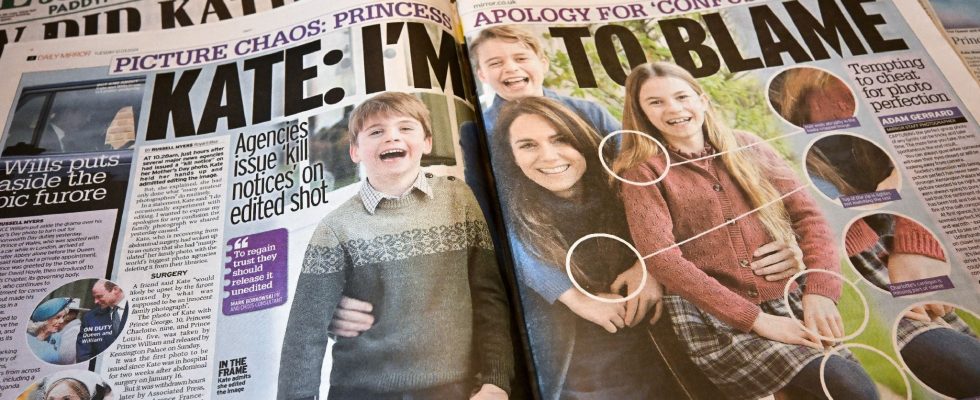“The image of chaos”, headlined the tabloid on Tuesday March 12 The Mirror, while the name “Kate” has been one of the most discussed topics since Sunday on X (formerly Twitter). Kate Middleton, Duchess of Cornwall and Cambridge, future Queen of the United Kingdom, has just apologized for having “amateurly” retouched a photo showing her surrounded by her three children, published on the occasion of Mother’s Day British, Monday March 10. Since several press agencies announced that they would no longer make the photo available, a number of observers have multiplied their comments on social networks, some noting the strange shape of little Louis’ fingers, others the absence of a wedding ring and a ring. engagement card on the hand of the princess.
This is the first official photo of Kate Middleton after she underwent abdominal surgery two months ago, which forced her to suspend her work for several weeks. The absence of the princess, and questions about her state of health, seem to have caused great anxiety in the country and beyond. This anecdotal episode says a lot about an era caught between two contradictory trends, the one which values authenticity – as evidenced by all the slices of life that we share on the networks – and the one which continues to celebrate exceptionality – as shown the extraordinary notoriety of certain personalities. As a result, we expect queens and stars to be like us, while being superior to us, like so many models or guides.
Kate Middleton proves to be the living embodiment of this duality, and it is undoubtedly for this reason that she has so far aroused so much interest and sympathy from the general public, in the United Kingdom and in the whole world. Coming from the upper middle class, pretty without being superb, pleasant when traveling, willingly photographed in jeans and sneakers with her family, this “girl next door” is none other than the future queen of the country, a distinguished woman who moves like a fish in water in the aristocracy and knows how to wear dresses with trains and tiaras with grace.
The limits of the “politics of authenticity”
Until now, Kate’s entourage has mastered this duality masterfully. After the fiasco of Lady Di, who could not fit into a rigid royal mold and ended up subject to the tabloid press that she had previously exploited, Kate and her advisors knew how to tame the media, starting with the formidable tabloids, by skilfully organizing the princess’s public appearances. The result is precise public appearances but also, frequently, seemingly authentic pieces of daily life. So, when Kate Middleton is seen perfectly dressed shopping with her children at the Sainsbury’s supermarket near King’s Lynn in August 2020, we suspected that the sequence had been carefully orchestrated. And in fact, this manufactured authenticity proves to be a formidable means of communication.
Everything goes wrong when the unexpected happens – and a non-trivial surgical operation is one of them, especially since no official information is available on the health of the person concerned. The general public, accustomed to seeing images of their princess in the newspapers at least once a week, suddenly found themselves deprived. After the latter left the hospital, the Cambridges seem to have been keen to give news of the princess, who was perhaps not in her best physical condition – hence the doctored photo. In this sense, they found themselves trapped in their “politics of authenticity”, discovering that it is only acceptable to the general public within certain limits. We’re dying to see the princess as she leaves her children’s school, but we don’t want to see her with dark circles and scars.
The “two bodies of the king”, or rather queens and stars, have perhaps never been so likely to merge, which is not without consequences. By showing themselves on the networks in their supposedly true light, our icons continue to compete in ingenuity to make their physical defects disappear, but without appearing to do so. We pose in pajamas or jogging pants without makeup, but the decor has been carefully studied and the complexion worked. In doing so, the queens and stars lie to us and we are complicit in this manipulation. Because if they are adored, it is precisely because they are not like the others, either because they have a particular talent, or because they have an extraordinary mission such as embodying the continuity of the State. In this sense, when you are a princess, you have to choose: either accept the disadvantages of authenticity when you want to benefit from them, or, when you are not ready to pay the price, prefer silence.
